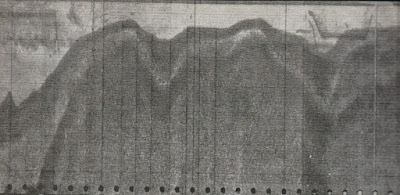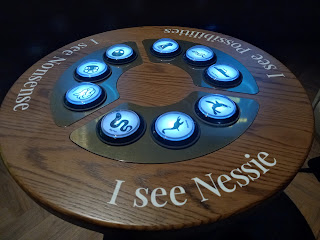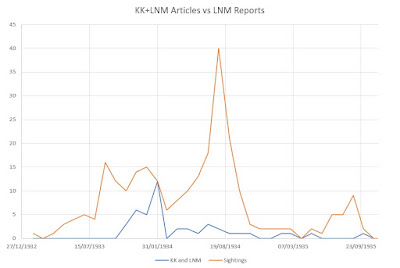A news item from the Scottish Sun took me by surprise today as it spoke of an "urgent warning as extensive Loch Ness Monster search could stir up a 'whirlpool of evil'". The text of the article was an interview with paranormal researcher, Ron Halliday and written by Oliver Norton (original link here).
A MASSIVE search to find the Loch Ness Monster could stir up a “whirlpool of evil”, a leading paranormal investigator has warned. Ron Halliday fears plans to flush out the elusive beast with drones, infrared cameras and underwater sound detectors later this month will lead to spirits being unleashed. Organisers are calling the two-day operation the biggest search for the monster in more than 50 years. But Mr Halliday, who has been investigating the paranormal for 30 years, said:
“I’d suggest this project be called off or at the very least there’s some psychic protection for anyone involved. I was concerned to read about plans for a massive search for the Loch Ness Monster. I’m not convinced this search is a good idea. We could be stirring up a whirlpool of evil.”
An army of volunteers is also set to watch the loch from safe vantage points on land surrounding Loch Ness on August 27 and 28. They have been warned to “stay vigilant” and bring binoculars and cameras to gather evidence. The effort is being organised by the Loch Ness Centre in Drumnadrochit and a volunteer research team called Loch Ness Exploration. The organisation’s Alan McKenna hoped the “large scale surface watch” would inspire a new generation of enthusiasts.
It’s understood to be the biggest search for the monster since the Loch Ness Investigation Bureau studied the waters in 1972. It will also involve technology not previously used before. But researcher Mr Halliday, who has published books including The A-Z of Paranormal Scotland and Scotland’s X-Files, warned the plans could backfire. He added:
“The truth is there’s little evidence that we’re dealing with a flesh-and-blood creature. It’s more likely that the loch is home to an unknown spirit form.”
Paul Nixon, General Manager of the Loch Ness Centre, said:
“The watch is designed to be observational and not invasive. The Loch is home to a whole host of wildlife and it is very important this does not become disturbed. Whilst we appreciate the offer of psychic protection we are confident our robust safety procedures will ensure a positive weekend for all involved in what will be the largest surface level search for Nessie on over 50 years.”
Now, speaking for myself, I have some experience in the paranormal theory of the Loch Ness Monster. I have studied the works of Ted Holiday, Anthony "Doc" Shiels and others such as Nick Redfern. I have also held to such views in earlier decades. My own contribution has been the book "The Water Horses of Loch Ness" which looks back on the ancient legends of the loch and elsewhere in the Highlands and the pre-Christian animism that pervaded the worldview of the inhabitants.
Where might the belief that the loch is a place not to be meddled with come from? Going way back to the beginning, what exactly the indigenous Picts of two thousand years ago believed was living in Loch Ness is not known. If they believed in some version of animism, then they may have regarded the entire body of water to be imbued with a spirit which was either part of its essence or distinct from it in some way. The practise of other cultures would suggest they may have offered gifts to the "spirit" of that water by throwing into it offerings of agriculture, livestock or even perhaps other humans in return for favourable outcomes such as fishing, good weather and so on.
The arrival of Christianity in the 6th century overturned that order and any spirit in or of the loch was demonized and subjugated to the God of the Christians. Over time, that "demon spirit" which continued to occasionally show itself to the perplexed natives with that long neck and horse like head became an infernal steed which preyed on unsuspecting travelers in a supernatural bait and switch tactic where its pseudo-equine form would transform from a saddled temptation for the weary walker to a terrifying plunge in its monstrous grip to depths unknown but always fatal.
Such was the Each Uisge of Loch Ness which held such a spell over the locals that it compelled them to keep silent about its appearances lest its curse broke forth upon them. Surely then such interventions as drones, cameras and sonar will once again stir up this "whirlpool of evil" which will do ... what?
Now I must admit when I read the headline, I immediately thought of the occultist, Kevin Carlyon, who has been known to cast a few spells over the water. That is nothing new as the loch was exorcised back in 1973 by the Reverend Donald Omand and doubtless various other incantations have been uttered over the cold, volatile waters. But this was Ron Halliday, Scottish paranormal researcher, who I have met on at least one occasion. Now if one believes there is something paranormal down there, you may be inclined to stay away from it.
Lat year, Ron was quoted as suggesting that the monster may be a creature inhabiting a parallel universe which can be seen when eyewitnesses inadvertently step into a "portal" between the two realms. That could even manifest as a view of a dinosaur from the distant past, though one may retort that dinosaurs belonged to our inverse, not a parallel one. Is he suggesting that the act of observing the loch could open such a portal and unleash something undesirable?
The problem with this theory is that it is essentially meaningless and endlessly malleable. How do you put it to test? What predictions can you make from this hypotheses and what experiments should be devised to verify it or correct it? The malleability is demonstrated to me in the quotes ascribed to Ron this week and last year. This week we are told "the loch is home to an unknown spirit form" but last year it inhabits another parallel universe - "something that looks solid but isn’t actually in our world". You can't have it both ways, which one is it?
Now perhaps Ron is being misquoted and he is welcome to clarify his views, but my own experience of the world of paranormal theories is that you can say almost anything and get away with it if you cloak it with some scientific terms such as parallel universes (which of course, have not been proven to exist). Now, some may hurl the same accusation at zoological Nessie theorists, but it is clear that speculating about giant eels and plesiosaurs is a far cry from creatures popping out of portals to parallel universes.
Paranormal theories go too far in what they employ to explain strange phenomena. Sure, you can use them to explain issues about food stocks in the loch or the lack of physical traces, just so long as you are happy importing another entire universe to explain what happens over a 26 mile stretch of water. This is not so much using a sledgehammer to crack a nut, but an entire division of tanks. In employing such theories, you destroy what you are trying to explain at the same time.
But the historical evidence does not back up such a statement about unleashing a "whirlpool of evil". Go back to the first extensive searches of the 1930s. The surge of people that rushed to the loch in the hope of seeing the monster. The various expeditions that occurred from 1933 into 1934. What evidence is there that evil was unleashed as a result of these activities?
Now jump thirty years to the 1960s and the large expeditions of the Loch Ness Investigation Bureau. The various watch stations with cameras, the surface watchers, the large number of volunteers involved, the publicity that surrounded them and the various experiments that developed as more experts got involved. What was unleashed back then? What tales of evil ensued that merited the cancellation of future work?
Moving into the 1970s with the large expeditions mounted by the Academy of Applied Science led by Robert Rines and the help of many based in Scotland and beyond. What misfortune came to pass that could even be classed as statistically significant beyond the normal run of good or bad luck people encounter in these ventures? For goodness sake, they even had a psychic in the form of Winifred Cary helping them with her dowsing! In fact, did not Ron Halliday go to Loch Morar armed with dowsing rods?
We could go on, what about Operation Deepscan in 1987 or the multiplicity of other incursions into the loch? But then again, if one wishes to scan these things in a paranormal manner, did not the Warlock Gregor MacGregor render the Loch Ness Kelpie impotent when he stole its bridle around the beginning of the 19th century? Well, at least, that is what he claimed. Or perhaps the threat of any whirlpool of evil was neutralized by the Reverend Omand in 1973 as he sprinkled the holy water over the loch?
One suspects that the recommended "psychic covering" is not needed. If there is a Loch Ness Spirit, it would probably rip through it like a wet paper bag. The news from the battle front of old was that the locals would send the Kelpie packing by invoking the name of the Holy Trinity. Perhaps they were following the example of St. Columba, who:
Looked on, while all who were there, as well the heathen as even the brethren, were stricken with very great terror; and, with his holy hand raised on high, he formed the saving sign of the cross in the empty air, invoked the Name of God, and commanded the fierce monster, saying, Think not to go further, nor touch thou the man. Quick! Go back! ' Then the beast, on hearing this voice of the Saint, was terrified and 'fled backward more rapidly than he came, as if dragged by cords.
Either that or you run your ass off. Either way, people, go prepared. Take all the usual precautions, be suited and booted, be aware of your surroundings, employ your concentration and don't play the fool. Call upon your god, be it deity or reason for Loch Ness, with or without a spirit can be an unforgiving environment to those who fall into its clutches.
And having done all that, enjoy yourselves, partake of the craich and don't forget to take that lens cap off.
Comments can be made at the Loch Ness Mystery Blog Facebook group.
The author can also be contacted at lochnesskelpie@gmail.com







































